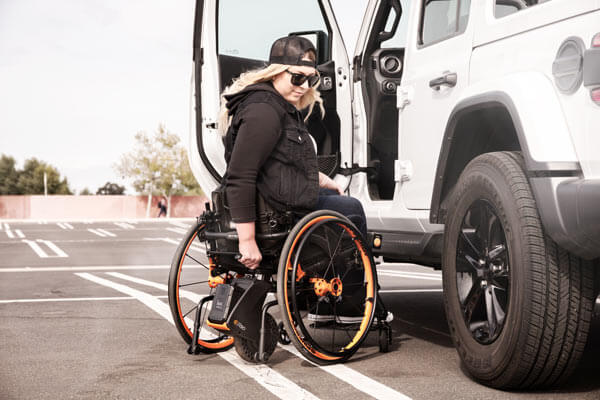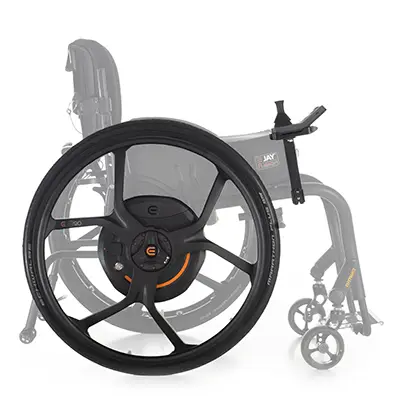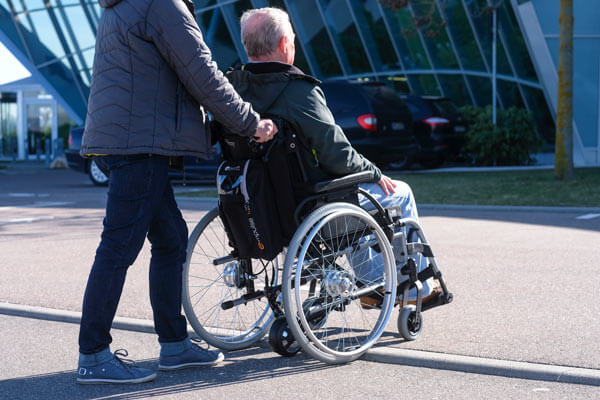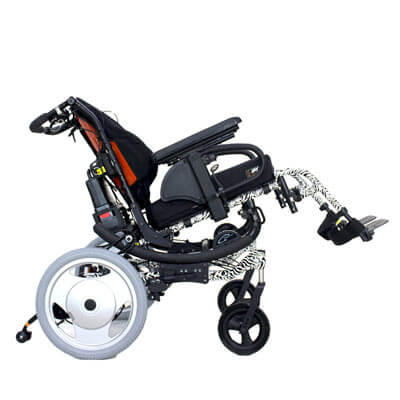Take it offline!
This Education in Motion resource is also available as a printable PDF.
Download PDF
When choosing a power assist/add-on device for a manual wheelchair, consider that each has distinct capabilities, benefits, and drawbacks. This guide provides an easy-to-understand overview of the considerations and implications for each broad category of devices.
| |
Independent Propulsion Power Assist |
Caregiver Power Assist |
| |
Push Devices |
Wheel Add-Ons |
Pull Devices (Indoor/Urban) |
Pull Devices (Outdoor/All-Terrain) |
Caregiver Push Devices |
Caregiver Wheel Add-Ons |
| Product Considerations |
|
| Wheelchair Compatibility |
★★★★★ |
★★★★☆ |
★★★★☆ |
★★★★☆ |
★★☆☆☆ |
★★★☆☆ |
| Air Travel Considerations |
★★★★★ |
★★★☆☆ |
★★☆☆☆ |
★★☆☆☆ |
★★★☆☆ |
★★☆☆☆ |
| Wheelchair Footprint |
★★★★★ |
★★★★☆ |
★★☆☆☆ |
★☆☆☆☆ |
★★☆☆☆ |
★★☆☆☆ |
| Control in Small Environments |
★★★★☆ |
★★★★★ |
★★☆☆☆ |
★☆☆☆☆ |
★★★☆☆ |
★★★★☆ |
| Use in Outdoor Environments |
★★★★☆ |
★★★★☆ |
★★☆☆☆ |
★★★★★ |
★★☆☆☆ |
★★★☆☆ |
| Use for Extended Distances |
★★★☆☆ |
★★★★☆ |
★★★☆☆ |
★★★★★ |
★★☆☆☆ |
★★★☆☆ |
| Client Considerations |
|
| Hand Function/Strength for Attaching to the Wheelchair |
★★★★☆ |
★★★☆☆ |
★★☆☆☆ |
★★☆☆☆ |
★★☆☆☆ |
★★☆☆☆ |
| Ease of Use |
★★★★☆ |
★★★★☆ |
★★★☆☆ |
★★☆☆☆ |
★★★★☆ |
★★★★☆ |
| Options for Degenerative Diagnosis |
★★☆☆☆ |
★★☆☆☆ |
★★☆☆☆ |
★★☆☆☆ |
★★★★☆ |
★★★★☆ |
| Considerations with Stopping |
★☆☆☆☆ |
★★☆☆☆ |
★★☆☆☆ |
★★☆☆☆ |
★★☆☆☆ |
★★★★★ |
| Compatibility for Hemiplegic Clients |
★★☆☆☆ |
★★☆☆☆ |
☆☆☆☆☆ |
☆☆☆☆☆ |
★★★★★ |
★★★★★ |
| Hand Function for Controlling |
★★★☆☆ |
★★☆☆☆ |
★★☆☆☆ |
★★☆☆☆ |
★★★★☆ |
★★★★☆ |
Independent Propulsion Power Assist
There is strong evidence for increased incidence of upper limb (UL) repetitive strain injuries (RSI) among manual wheelchair users. These injuries occur due to repetitive movements and result in muscle tears, inflammation, nerve impingement, bursitis, and pain. They primarily affect the shoulders, wrists, and elbows and can manifest as rotator cuff impairments, carpal tunnel syndromes, and "tennis elbow," among other symptoms. Research indicates that power assist devices can help to preserve independent function & UL health and reduce risk of future damage while still allowing independent mobility with a manual wheelchair.
Push Devices
A unit is clamped on to the wheelchair frame and "pushes" the manual wheelchair forward. Speed on/off is controlled by a hand controller generally mounted on the side rail.
 Push devices are generally the easiest power-assist devices to attach and remove
Push devices are generally the easiest power-assist devices to attach and remove
Product Considerations
WHEELCHAIR COMPATIBILITY
★★★★★
Factor
Most can be used with either folding or rigid manual wheelchairs, but require different brackets depending on type and width.
Consideration
Consider the bracket's weight.
AIR TRAVEL CONSIDERATIONS
★★★★★
Factor
These are the smallest and lightest of the models. Consider whether the battery can be easily removed for air travel. A few have lithium batteries that can be removed and put into the cargo hold of the plane (with prior approval of the airline).
Consideration
Check that the size of the battery meets both distance and transportation requirements.
WHEELCHAIR FOOTPRINT
★★★★★
Factor
The power assist device is mounted to the wheelchair's camber tube to prevent adding width to the system. Some devices add length.
Consideration
For the devices that do add length, consider how this will affect maneuverability, especially in small areas.
CONTROL IN SMALL ENVIRONMENTS
★★★★☆
Factor
Good in small environments if the client can control it well. The client will need to pay attention and monitor speed in tighter/busier environments.
Consideration
Consider the client's cognitive ability and wheelchair skills.
USE IN OUTDOOR ENVIRONMENTS
★★★★☆
Factor
Best suited for harder ground and pavement.
Consideration
Depending on the terrain, it can lose traction on soft surfaces like grass and dirt.
USE FOR EXTENDED DISTANCES
★★★☆☆
Factor
Great for longer distance travel.
Consideration
It's not a power wheelchair, but it will allow the client to go further with less fatigue/effort.
Client Considerations
HAND FUNCTION AND STRENGTH FOR ATTACHING/DETACHING TO THE WHEELCHAIR
★★★★☆
Factor
These devices are generally one of the lighter devices in comparison to the other types (13-17 lbs.), allowing easier connection or removal from the wheelchair.
Consideration
Consider if the client has range of motion, motor control, and strength to remove the device. In some models, the wheel can retract off the ground so it doesn't need to be removed when not being used.
EASE OF USE
★★★★☆
Factor
Some systems have simple dials to change the speed, some use push buttons, and some use a series of taps. These devices do not have a braking function and require the rider to stop the wheelchair using handrims after cutting power to the unit using the control system.
Consideration
Consider whether your client has the cognitive ability and reaction speed to adequately control the device, especially in busy areas or at faster speeds. Some of the devices are not as intuitive to use.
OPTIONS FOR DEGENERATIVE DIAGNOSIS
★★☆☆☆
Factor
Most of these devices can be programmed to adapt to declining strength and UL function. Some are able to adapt to the loss of ability on one side (hemiplegia).
Consideration
Push devices do not have the same programming capabilities as a power wheelchair, and power seat functions can't be added. Consider whether your client would be better suited for a power wheelchair.
CONSIDERATIONS WITH STOPPING
★☆☆☆☆
Factor
Clients need to have the strength to stop the wheelchair by holding the handrims/wheels.
Consideration
Once the chair is set in motion, even if they turn off the device, the chair does not have brakes like a power wheelchair. They will need to physically stop the wheelchair.
COMPATIBILITY FOR HEMIPLEGIC CLIENTS
★★☆☆☆
Factor
Most can be controlled by one hand. Remember they require the rider to stop the wheelchair using the handrims after cutting power to the unit using the control system.
Consideration
These devices can be challenging to use for full hemiplegics.
HAND FUNCTION FOR CONTROLLING
★★★☆☆
Factor
These devices have some type of a control box for speed and on/off.
Consideration
Consider whether your client has adequate strength and finger function to safely control the wheelchair.
Jump back to table
Wheel Add-Ons
Motors are incorporated into the wheels, which then provide forward propulsion.
 Empulse M90 wheel add-on
Empulse M90 wheel add-on
Product Considerations
WHEELCHAIR COMPATIBILITY
★★★★☆
Factor
Most can be used with either folding or rigid manual wheelchairs, but require different brackets depending on type.
Consideration
With most devices, the wheels are similar to a normal manual wheelchair but with extra weight. The tire options may be limited.
AIR TRAVEL CONSIDERATIONS
★★★☆☆
Factor
Consider whether the battery can be easily removed for airline travel or transport. Powered wheels need to be stowed carefully.
Consideration
Check that the size of the battery meets transportation requirements. Also some device batteries are easier to remove than others.
WHEELCHAIR FOOTPRINT
★★★★☆
Factor
Most add little size to the wheelchair. Some may add width depending on the unit selected.
Consideration
Consider if the increased width will impede function.
CONTROL IN SMALL ENVIRONMENTS
★★★★★
Factor
Great in small environments where maneuverability is essential, as the client is fully in control of the device.
Consideration
A winner in this regard as long as the footprint size isn't altered and the width doesn't impede getting through doorways or reduce maneuverability.
USE IN OUTDOOR ENVIRONMENTS
★★★★☆
Factor
Best suited for harder ground and pavement.
Consideration
Remember: it is not a power wheelchair and it has normal manual wheelchair-sized wheels and tires.
USE FOR EXTENDED DISTANCES
★★★★☆
Factor
Great for longer distance travel.
Consideration
It's not a power wheelchair, but it will allow the client to go further with less fatigue/effort.
Client Considerations
HAND FUNCTION AND STRENGTH FOR ATTACHING/DETACHING TO THE WHEELCHAIR
★★★☆☆
Factor
This type of device adds weight to the wheels - some add significant weight, others are minimal additional weight.
Consideration
Consider whether the wheels will need to be removed and how often. Is this doable by the client or family?
EASE OF USE
★★★★☆
Factor
This device can be steered with the handrims or with a joystick, making it intuitive and easy to learn & use. As the size of the chair does not change, it is still easy to maneuver in small spaces.
Consideration
Some cognitive ability and reaction speed is required, especially in busy areas or at faster speeds.
OPTIONS FOR DEGENERATIVE DIAGNOSIS
★★☆☆☆
Factor
Most wheel add-on devices can be programmed for increasing weakness or to accommodate strength differences.
Consideration
Wheel add-on devices do not have the same capabilities as a power wheelchair, nor can power seat functions be added. Consider whether your client would be better suited to a power wheelchair.
CONSIDERATIONS WITH STOPPING
★★☆☆☆
Factor
Clients need to have the strength to stop the wheelchair by holding the handrims/wheels.
Consideration
Consider whether the unit has braking function to allow the rider to slow down through handrim control. This would require less force than without the power assist.
COMPATIBILITY FOR HEMIPLEGIC CLIENTS
★★☆☆☆
Factor
Can program for one side substantially weaker than the other. Will likely need to use a foot for accurate steering.
Consideration
These devices can be challenging to use for full hemiplegics.
HAND FUNCTION FOR CONTROLLING
★★☆☆☆
Factor
These devices require the client to push the handrims like a normal manual wheelchair, but they multiply the force generated and can extend the distance per push.
Consideration
Consider whether your client has adequate strength and control to push the handrim.
Jump back to table
Pull Devices
A front wheel assembly is attached to the frame of the wheelchair and a motorized wheel provides the power. Handlebars allow the client to steer.
Product Considerations
WHEELCHAIR COMPATIBILITY
Factor
These devices require a fixed frame section to attach the unit. This can either be the frame of fixed front hangers.
Consideration
Consider how the device attaches to the wheelchair and how this affects transfers.
AIR TRAVEL CONSIDERATIONS*
Factor
These devices are bigger and heavier than the other types of power-assist devices. Battery size also depends on the unit.
Consideration
Consider size / capacity of battery and guidelines for air travel. Also consider whether the battery can be easily removed from the unit for air travel.
WHEELCHAIR FOOTPRINT*
Factor
This device will add substantial length to the wheelchair. Depending on the device, it can substantially reduce maneuverability.
Consideration
Best used in urban or outdoor environments.
CONTROL IN SMALL ENVIRONMENTS
Factor
Depending on the device, they can substantially reduce maneuverability indoors.
Consideration
Great in outdoor environments and should be removed for most indoor environments. Depending on the device, some are easier to remove than others.
USE IN OUTDOOR ENVIRONMENTS
Factor
Great for outdoor activities. Depending on the device, they can have substantial speed and torque.
Consideration
Does the client have the wheelchair skills and cognitive ability to use the device safely?
USE FOR EXTENDED DISTANCES
Factor
Great for longer distance outdoor travel.
Consideration
As there are many different models, make sure the wheel size and power suits the client's needs and activities.
* Varies depending on specific unit.
Client Considerations
HAND FUNCTION AND STRENGTH FOR ATTACHING/DETACHING TO THE WHEELCHAIR
Factor
These devices are heavier and generally require good hand function to attach to the wheelchair. Some units have simple docking or kickstands to support.
Consideration
Consider if the client has the hand function to use. Also, consider whether the attachment clamps stay on the chair (adding weight) when the device is not in use.
EASE OF USE
Factor
These devices are controlled by handlebars with both a throttle and squeeze-trigger brakes. Some units offer quad grips for clients with less hand function.
Consideration
Does the client have trunk control and limb function to control safely at higher speeds and over uneven terrain?
OPTIONS FOR DEGENERATIVE DIAGNOSIS
Factor
These devices require good trunk and upper extremity function.
Consideration
May be tricky for progressive disabilities.
CONSIDERATIONS WITH STOPPING
Factor
Depending on the power assist, it will have manual hand brakes, electronic brakes, or both.
Consideration
Does the client have adequate trunk control and limb/hand function to manage the brakes?
COMPATIBILITY FOR HEMIPLEGIC CLIENTS
Factor
These devices are difficult to use for full hemiplegics.
Consideration
A different device should be considered for full hemiplegics.
HAND FUNCTION FOR CONTROLLING
Factor
These devices are controlled by handlebars, requiring upper limb strength to steer.
Consideration
Does the client have the strength and endurance to safely manage the device? Some units offer quad grips for clients with less hand function.
Jump back to table
Caregiver Power Assist
There are clients unable to functionally propel manual wheelchairs and cannot successfully operate a power wheelchair. For these clients, research has shown power assist devices can better allow caregivers to provide this mobility, improving client function and participation.
Caregiver Push Devices
A powered wheel is attached to the wheelchair, generally to the rear. These devices are designed for clients who are dependent on carers for mobility but who are also not power wheelchair candidates.
 Caregiver push devices can help with climbing curbs
Caregiver push devices can help with climbing curbs
Product Considerations
WHEELCHAIR COMPATIBILITY
★★☆☆☆
Factor
Most of these devices can be used with either a folding, rigid, or tilt-in-space wheelchair. Depending on the device, it can be removed for vehicle transport or the client can sit in the system during transport.
Consideration
Some devices have limitations on the type of tires and wheels that can be utilized.
AIR TRAVEL CONSIDERATIONS
★★★☆☆
Factor
Models differ in this category in regard to how the battery is removed for storage, transport, or charging.
Consideration
Consider the battery's location and whether it's easy to remove for storage or transport.
WHEELCHAIR FOOTPRINT
★★☆☆☆
Factor
Depending on the device, this type of power add-on can add length to the wheelchair.
Consideration
As the unit is generally mounted at the rear of the wheelchair, consider whether this impedes a carer walking behind the wheelchair.
CONTROL IN SMALL ENVIRONMENTS
★★★☆☆
Factor
These devices work quite well in small environments.
Consideration
As the unit is generally mounted at the rear of the wheelchair, consider if the unit adds length.
USE IN OUTDOOR ENVIRONMENTS
★★☆☆☆
Factor
These devices are designed for more urban outdoor environments and generally have slower maximum speeds.
Consideration
Consider whether an add-on wheel can manage the speed and terrain the client requires.
USE FOR EXTENDED DISTANCES
★★☆☆☆
Factor
These devices are designed for assisting caregivers in moving a wheelchair over longer distances.
Consideration
Consider whether an add-on wheel can manage the speed and terrain the client requires.
Client Considerations
HAND FUNCTION AND STRENGTH FOR ATTACHING/DETACHING TO THE WHEELCHAIR
★★☆☆☆
Factor
Models differ in this category in regard to product weight and how they attach to the chair.
Consideration
Consider the ease of adding / removing the device. It's also important to consider if the wheelchair can be folded with the device in place.
EASE OF USE
★★★★☆
Factor
Most units are simple to use with on/off and speed adjustments.
Consideration
Most caregivers can understand and use these devices successfully.
OPTIONS FOR DEGENERATIVE DIAGNOSIS
★★★★☆
Factor
As these are controlled by the attendant, client loss of function will not impact these devices.
Consideration
Push devices do not have the same capabilities as a power wheelchair, and power seat functions cannot be added. Consider whether a large change in function is anticipated and whether the client might be better suited to a power wheelchair.
CONSIDERATIONS WITH STOPPING
★★☆☆☆
Factor
The device has power and speed up/down control. Depending on the device, it may or may not have electronic braking.
Consideration
Does the caregiver have adequate strength / skill to manage the chair in the necessary environments, including steering and stopping? Some devices may not have electronic brakes.
COMPATIBILITY FOR HEMIPLEGIC CLIENTS
★★★★★
Factor
As these devices are controlled by the attendant, they can be appropriate for more complex hemiplegic clients.
Consideration
Appropriate for dependent hemiplegic users. Remember: it does not have the capacity of a power wheelchair.
HAND FUNCTION FOR CONTROLLING
★★★★☆
Factor
These devices have some type of a control box to adjust speed and on/off. This control box is mounted in the attendant position on the back canes.
Consideration
Some devices use very simple dials/push buttons. Others use squeeze triggers. Consider the ease of use for the caregiver.
Jump back to table
Caregiver Wheel Add-On
Powered wheels are attached to the wheelchair, replacing the normal rear wheels. These devices are designed for clients who are dependent on carers for mobility but who are not power wheelchair candidates.
 ZIPPIE iXpress caregiver wheel add-on
ZIPPIE iXpress caregiver wheel add-on
Product Considerations
WHEELCHAIR COMPATIBILITY
★★★☆☆
Factor
Most of these devices can be used with either a folding, rigid, or tilt-in-space wheelchair.
Consideration
Some devices have limitations on the type of tires that can be utilized. Consider if this is an important maintenance issue.
AIR TRAVEL CONSIDERATIONS
★★☆☆☆
Factor
Models differ in this category in regard to how the battery is removed for storage, transport, or charging.
Consideration
Consider the battery's location and whether it's easy to remove for storage or transport.
WHEELCHAIR FOOTPRINT
★★☆☆☆
Factor
The powered wheels can add to the overall width of the wheelchair.
Consideration
Consider if the increase in width will impede function and maneuverability.
CONTROL IN SMALL ENVIRONMENTS
★★★★☆
Factor
Most devices do not add additional length to the wheelchair, but could add width.
Consideration
A winner in this regard as long as the added width doesn't impede getting through doorways or reduce maneuverability.
USE IN OUTDOOR ENVIRONMENTS
★★★☆☆
Factor
These devices are designed for urban outdoor environments with harder surfaces.
Consideration
A great solution for a dependent user who is not a power wheelchair candidate and is using the device mostly on sidewalks and paved surfaces.
USE FOR EXTENDED DISTANCES
★★★☆☆
Factor
These devices are designed for urban outdoor environments. They generally have higher speeds, more power, and a bit more capacity when compared to add-on wheel devices.
Consideration
A great solution for a dependent user who is not a power wheelchair candidate and whose carer cannot push a manual wheelchair over the distances required.
Client Considerations
HAND FUNCTION AND STRENGTH FOR ATTACHING/DETACHING TO THE WHEELCHAIR
★★☆☆☆
Factor
Models differ in this category in regard to product weight and how they attach to the chair. Some are considerably more complicated to remove than others.
Consideration
Consider if the device needs to be removed from the wheelchair. Most can stay on a wheelchair permanently. If the chair needs to be folded, consider if the device allows this.
EASE OF USE
★★★★☆
Factor
Most units are simple to use with on/off and speed adjustments.
Consideration
These devices are simple to learn how to use.
OPTIONS FOR DEGENERATIVE DIAGNOSIS
★★★★☆
Factor
As these are controlled by the attendant, client loss of function will not impact these devices.
Consideration
Wheel add-on devices do not have the same capabilities as a power wheelchair, and power seat functions cannot be added. Consider whether a large change in function is anticipated and whether the client might be better suited to a power wheelchair.
CONSIDERATIONS WITH STOPPING
★★★★★
Factor
These devices have power and speed up/down control. Depending on the device, it may or may not have electronic braking.
Consideration
These devices are easy for caregivers to use.
COMPATIBILITY FOR HEMIPLEGIC CLIENTS
★★★★★
Factor
As these devices are controlled by the attendant, client hemiplegia will not impact their use of the device.
Consideration
Appropriate for dependent hemiplegic users. Remember: it does not have the capacity of a power wheelchair.
HAND FUNCTION FOR CONTROLLING
★★★★☆
Factor
These devices have some type of a control box to adjust speed and on/off. This control box is mounted in the attendant position on the back canes.
Consideration
Some devices use very simple dials/push buttons. Consider the ease of use for the attendant.
Jump back to table
References
- Kentar, Y. et al. 2018. Prevalence of upper extremity pain in a population of people with paraplegia. Spinal Cord 56, 695-703.
- Choukou, Best, K. L., Potvin-Gilbert, M., Routhier, F., Lettre, J., Gamache, S., Borisoff, J. F., & Gagnon, D. (2021). Scoping review of propelling aids for manual wheelchairs. Assistive Technology, 33(2), 72-86. https://doi.org
- Didier Pradon, Elodie Garrec, Isabelle Vaugier, Thierry Weissland & Caroline Hugeron (2021) Effect of power-assistance on upper limb biomechanical and physiological variables during a 6-minute, manual wheelchair propulsion test: a randomised, cross-over study, Disability and Rehabilitation, DOI: 10.1080/09638288.2021.1973586
- Elliot W. Flockhart, William C. Miller, Jory A. Campbell, Johanne L. Mattie & Jaimie F. Borisoff (2021) Evaluation of two power assist systems for manual wheelchairs for usability, performance and mobility: a pilot study, Disability and Rehabilitation: Assistive Technology, DOI: 10.1080/17483107.2021.200106
- Khalili, Eugenio, A., Wood, A., Van der Loos, M., Mortenson, W. B., & Borisoff, J. (2021). Perceptions of power-assist devices: interviews with manual wheelchair users. Disability and Rehabilitation: Assistive Technology, ahead-of-print(ahead-of-print), 1-11. https://doi.org
- Sawatzky, Mortenson, W. B., & Wong, S. (2018). Learning to use a rear-mounted power assist for manual wheelchairs. Disability and Rehabilitation: Assistive Technology, 13(8), 772-776. https://doi.org
- Wong, Mortenson, B., & Sawatzky, B. (2019). Starting and stopping kinetics of a rear mounted power assist for manual wheelchairs. Assistive Technology, 31(2), 77-81. https://doi.org